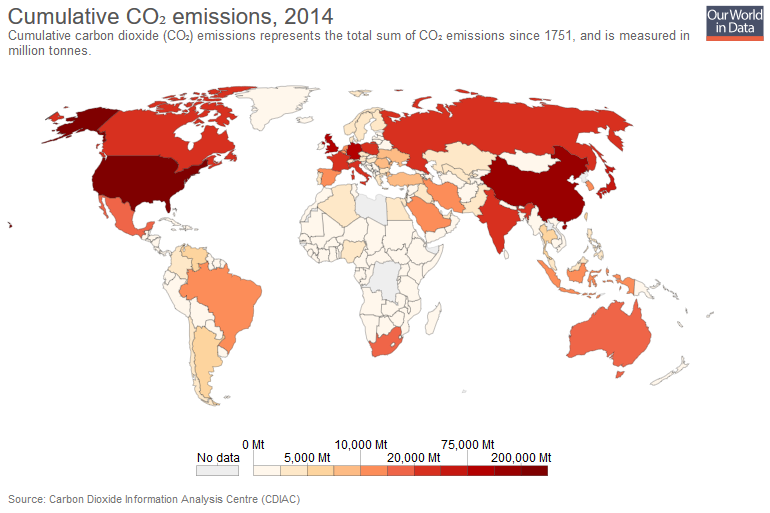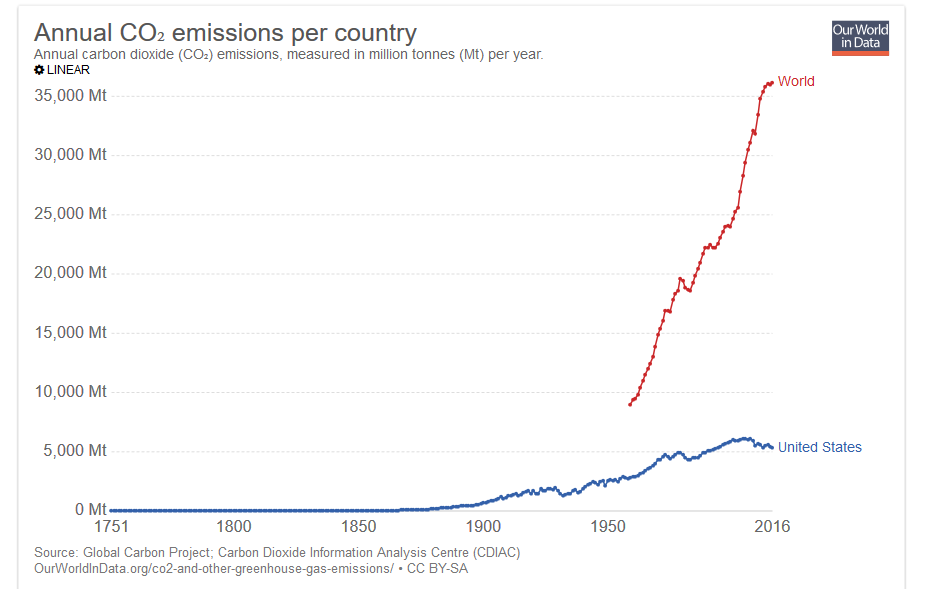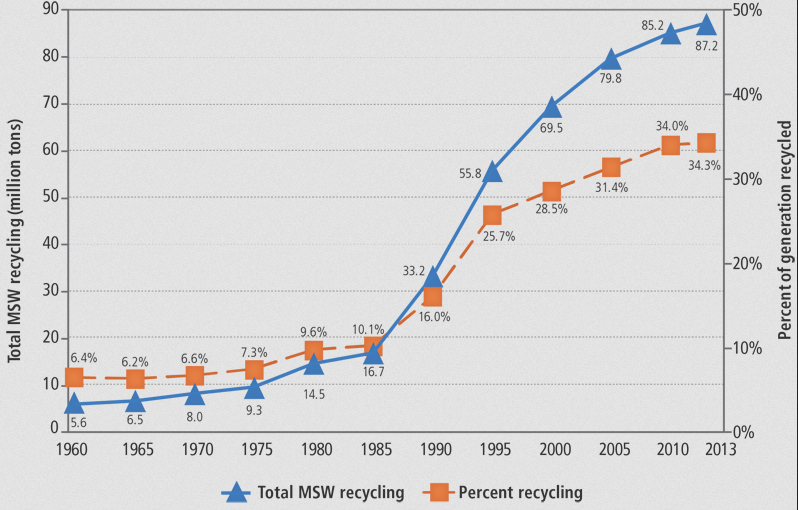Sustainability: Go Big or Go Home
I really like HEB, the Texas grocery store, but one thing that grinds my gears is their incorrigible reluctance to use the old shopping bags that I bring to save plastic. One day, the cashier placed my groceries in the bag I brought – then before I could stop her, placed that bag in a new shopping bag. Of course, saving the individual bag’s 5.5 grams / 0.19 ounces of polyethylene would do nothing to mitigate the harmful effects of the plastic bag industry’s use of energy and material. Nor would the ⅓ or ½ kilogram I might save in a good year. However, if as a society we tried to reform our habits, what kind of positive effect might we have?
Quantitative estimates of the potential benefits of certain changes in habits (specifically I looked at plastic bag usage and carpooling to school) led me to this conclusion: It takes a lot for individuals – even if it is a majority of individuals in our society – to change their living habits in a way that makes a meaningful impact. Unwilling to end on such a cynical note, I sought in the numbers the answer to another question: What changes would need to be made to significantly slow our consumption of resources and generation of pollution?
Bags on Bags
The Wall Street Journal cites an estimate that 100 billion plastic bags are thrown away each year in the United States. If half of the plastic bag users reused half of their bags for the year, 25 billion fewer bags, or about 225 million kg of plastic, would be saved. This is 0.4% of the approximately 31 million tons of plastic used by Americans each year, per data from EUROMAP. This is a reasonably impactful change considering that reusing bags would not cause an undue hardship or inconvenience to most American families. But 0.4% would not truly change the massive flow of plastic into landfills and the oceans.
Cars on Cars: A Closer Look
I found similar results when I looked at the potential impact of doubling the rate of students (age 6-18) who carpooled to school. Here I detail a deeper dive into how I calculated the numbers, because it a) provides perspective on the enormity of our carbon dioxide emissions, and b) knowing numbers behind our present situation gives us the opportunity to understand how to perhaps make more significant improvements.
In brief:
- If half of the children who drive but do not carpool (i.e., they are alone in the car, except for the driver, if they are not driving themselves), carpooled with one other person, each year in the U.S. 272 million gallons of gasoline would be saved, reducing carbon dioxide emissions by 2.72 Megatonnes, or 5.44 billion pounds.
- This would reduce yearly CO2 emissions in America’s transportation sector by 0.14%
This shift in carpooling habits would leave 99.86% of the country’s transportation emissions (which in turn make up 28% of the country’s overall CO2 emissions). A tiny proportion – to give a sense of scale, the figure below from Our World in Data shows that since the beginning of humanity’s industrialization in the 1700s, about 376,000 megatonnes of CO2 have been released in the US.

2.72 Mt would be equivalent to the United States’ emissions in 1831:

A quick outline of these numbers’ derivation:
-
Number of school-age children in the US: 58.3 million, (per American Community Survey).
-
Percent of children who drive or are driven to school: 56% (per National Household Travel Survey, Jan 2008).
-
Percent of children who do not carpool – they either drive themselves or are driven by their parent or another non-student with no other student in the car: 50% (NHTS).
-
These 3 figures come out to 16,324,000 children not carpooling to school. If half of them paired up, there would be 25% fewer trips to school taken each day: 4.08 million fewer trips per day.
-
Average distance to school of 4.7 miles (NHTS) x 4.08 million trips saved = 19 million fewer miles per day (one way), 38 million fewer miles total per day.
-
Assuming 175 days in a school year, that’s 6.72 billion fewer miles per year.
-
Average fuel economy of cars in the U.S. is 24.7 miles per gallon; this yields 272 million fewer gallons of fuel burned per year.
-
Burning one gallon of gasoline produces 20 pounds of CO2 (fueleconomy.gov), saving 272 million gallons saves 5.44 billion pounds of CO2.
Having these numbers in a spreadsheet allows us to see how changing a certain figure changes the overall result. Even if all the solo drivers paired up, “only” 5.4 Mt of CO2 would be saved, a 0.28% reduction in the nation’s emissions from transportation.
One more discouraging note to keep in mind: it is no secret that we use tons (actually, millions of tons) of petroleum in plastic production and in our cars. Yet, our breakneck pace of consumption continues, perhaps influenced strongly by each individual’s feeling (and indeed, knowledge), that changing his or her habits will not change the overall environmental outlook.
So now what?
Fortunately, the data can also clue us in to what changes could provide meaningful benefits. Let’s stick with the problem of automobile emissions before returning to the plastic bags. What numbers would need to change to get to the point where we’re making a 1% difference in emissions from transportation?
- If only 10%, rather than the current roughly 50%, of school children drove to school (walking, biking, or using mass transport instead), 9Mt of CO2 would be saved per year – 0.94% reduction in the transportation sector.
Not bad considering we’re dealing only with students (elementary/high school), whose commutes only occur 175/365 days out of the year. If the half of those who drive to work used alternate means of transportation (43% driving rather than the current 86%, per American Community Survey), emissions due to transportation would fall by a pretty hefty 9.64%.
This analysis reveals the depth of change we need to make in order to meaningfully slow pollution and climate change. A major change in habit – doubling the number of students who carpool – would cut barely a thousandth of the country’s emissions that stem from transportation. To get to the one percent mark, we would need to cut the number of students who drive to school by 80%. This goes beyond a change in daily routine; even if every family wanted to walk, bike, or take the school bus or public transit to school, the infrastructure in our country would prevent many of them. Safety concerns and lack of public transport routes make this change in habit impossible for many.
How about plastic? The recycling rate in the U.S. is about 30% (the figure from the EPA, below, shows the recycling rate of all types of solid waste, which overall is higher than the plastic-only recycling waste).

A 10% increase in recycling rate (i.e. from 30% to 33%) would correspond to a decent 3% decrease in plastic consumption. So the answer is simple, right? People should stop throwing their plastic bags and bottles in the trash. While this is true, we cannot ignore the other challenge to recycling: someone has to spend their time, money, and electricity/heat to collect and process the plastic. It at first seems illogical that my apartment complex that houses hundreds of beer, soda, and water bottle consumers doesn’t have a recycling dumpster. But unless my city has some obscure anti-recycling ordinance, the reason is rooted in the simplest, most logical economics. It is not profitable for a company to bring and periodically empty a dumpster, transport the plastic, process it, and resell it. Until that incentive exists, convenience will drive my fellow apartment residents and their beer bottles to the green trash dumpster a minute’s walk from their door. So while it may be more practical for individuals to increase their recycling rate than their carpooling rate, there is no evidence to suggest to policy makers that this will happen from a sudden increase in love of the environment. The rational actor will look around, realize that his lack of recycling is insignificant in the bigger picture and instead do what makes the most sense for him in terms of time and convenience (I will re-emphasize that this is not selfishness; our rational actor has crunched the numbers and knows that his individual contribution is irrelevant to the problem of our national waste generation).
A healthier environment most likely cannot be achieved merely through a “bottom-up” solution where individuals and communities reform their habits and resource consumption. Large amounts of resources and organizational energy must be invested to change our infrastructure and technology, enabling the shifts in routine that will meaningfully reduce our resource consumption and environmental impact. And still, this would need to be complemented by changes in our lifestyle; having buses, bike paths, and recycling bins available provides no benefit if they are unused.
This article isn’t news; it is adding quantification to what most of us already know. Small, convenient fixes won’t slow the damage we are causing to the environment. Changes – some of them difficult – need to be made at every level: individuals need to buy in, and governments and corporations need to give them the tools to make an impact. Improving our habits can be good – but it must never be seen as an alternative to the systematic, deep-rooted changes we truly need.
 The Syntact Project
The Syntact Project